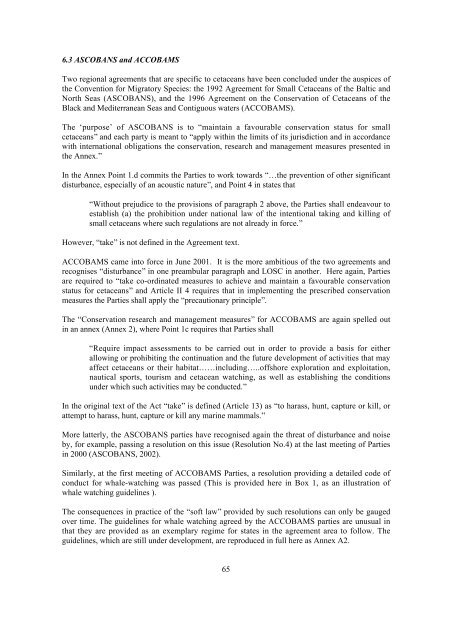Oceans of noise - Whale and Dolphin Conservation Society
Oceans of noise - Whale and Dolphin Conservation Society
Oceans of noise - Whale and Dolphin Conservation Society
You also want an ePaper? Increase the reach of your titles
YUMPU automatically turns print PDFs into web optimized ePapers that Google loves.
6.3 ASCOBANS <strong>and</strong> ACCOBAMS<br />
Two regional agreements that are specific to cetaceans have been concluded under the auspices <strong>of</strong><br />
the Convention for Migratory Species: the 1992 Agreement for Small Cetaceans <strong>of</strong> the Baltic <strong>and</strong><br />
North Seas (ASCOBANS), <strong>and</strong> the 1996 Agreement on the <strong>Conservation</strong> <strong>of</strong> Cetaceans <strong>of</strong> the<br />
Black <strong>and</strong> Mediterranean Seas <strong>and</strong> Contiguous waters (ACCOBAMS).<br />
The ‘purpose’ <strong>of</strong> ASCOBANS is to “maintain a favourable conservation status for small<br />
cetaceans” <strong>and</strong> each party is meant to “apply within the limits <strong>of</strong> its jurisdiction <strong>and</strong> in accordance<br />
with international obligations the conservation, research <strong>and</strong> management measures presented in<br />
the Annex.”<br />
In the Annex Point 1.d commits the Parties to work towards “…the prevention <strong>of</strong> other significant<br />
disturbance, especially <strong>of</strong> an acoustic nature”, <strong>and</strong> Point 4 in states that<br />
“Without prejudice to the provisions <strong>of</strong> paragraph 2 above, the Parties shall endeavour to<br />
establish (a) the prohibition under national law <strong>of</strong> the intentional taking <strong>and</strong> killing <strong>of</strong><br />
small cetaceans where such regulations are not already in force.”<br />
However, “take” is not defined in the Agreement text.<br />
ACCOBAMS came into force in June 2001. It is the more ambitious <strong>of</strong> the two agreements <strong>and</strong><br />
recognises “disturbance” in one preambular paragraph <strong>and</strong> LOSC in another. Here again, Parties<br />
are required to “take co-ordinated measures to achieve <strong>and</strong> maintain a favourable conservation<br />
status for cetaceans” <strong>and</strong> Article II 4 requires that in implementing the prescribed conservation<br />
measures the Parties shall apply the “precautionary principle”.<br />
The “<strong>Conservation</strong> research <strong>and</strong> management measures” for ACCOBAMS are again spelled out<br />
in an annex (Annex 2), where Point 1c requires that Parties shall<br />
“Require impact assessments to be carried out in order to provide a basis for either<br />
allowing or prohibiting the continuation <strong>and</strong> the future development <strong>of</strong> activities that may<br />
affect cetaceans or their habitat……including…..<strong>of</strong>fshore exploration <strong>and</strong> exploitation,<br />
nautical sports, tourism <strong>and</strong> cetacean watching, as well as establishing the conditions<br />
under which such activities may be conducted.”<br />
In the original text <strong>of</strong> the Act “take” is defined (Article 13) as “to harass, hunt, capture or kill, or<br />
attempt to harass, hunt, capture or kill any marine mammals.”<br />
More latterly, the ASCOBANS parties have recognised again the threat <strong>of</strong> disturbance <strong>and</strong> <strong>noise</strong><br />
by, for example, passing a resolution on this issue (Resolution No.4) at the last meeting <strong>of</strong> Parties<br />
in 2000 (ASCOBANS, 2002).<br />
Similarly, at the first meeting <strong>of</strong> ACCOBAMS Parties, a resolution providing a detailed code <strong>of</strong><br />
conduct for whale-watching was passed (This is provided here in Box 1, as an illustration <strong>of</strong><br />
whale watching guidelines ).<br />
The consequences in practice <strong>of</strong> the “s<strong>of</strong>t law” provided by such resolutions can only be gauged<br />
over time. The guidelines for whale watching agreed by the ACCOBAMS parties are unusual in<br />
that they are provided as an exemplary regime for states in the agreement area to follow. The<br />
guidelines, which are still under development, are reproduced in full here as Annex A2.<br />
65

















